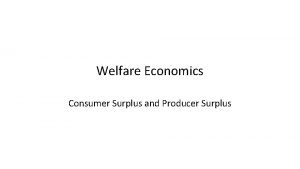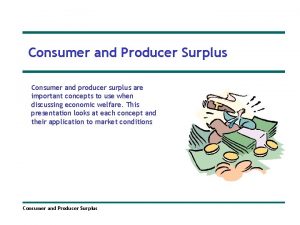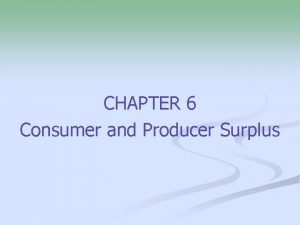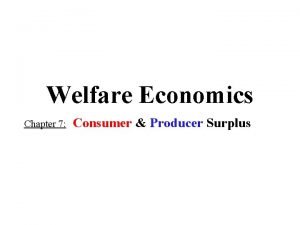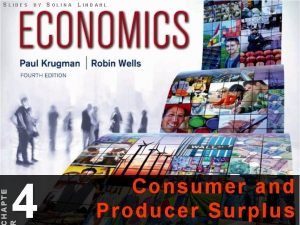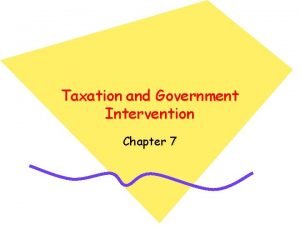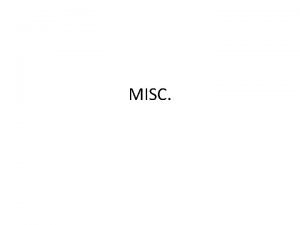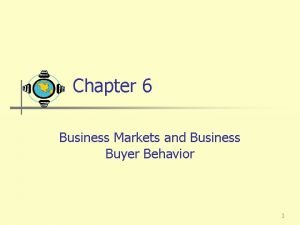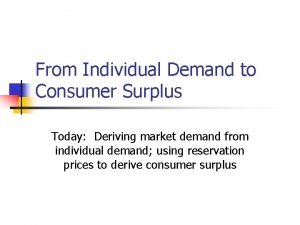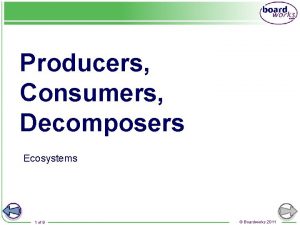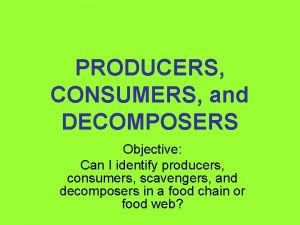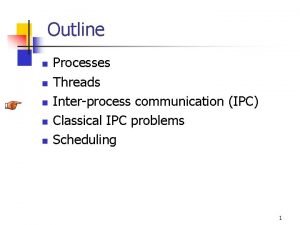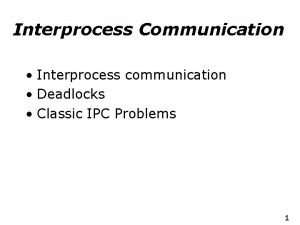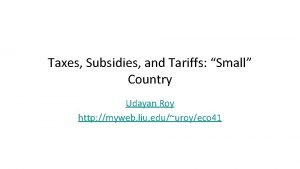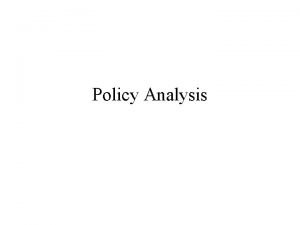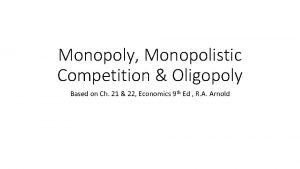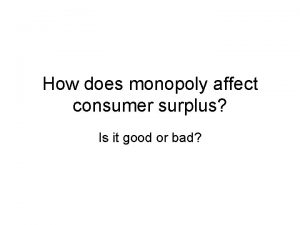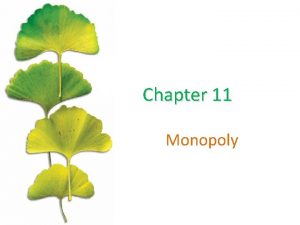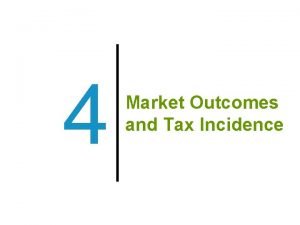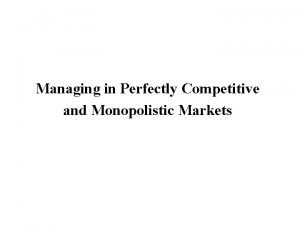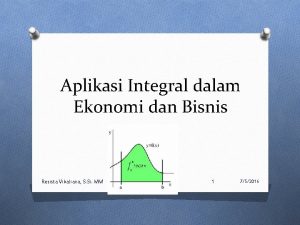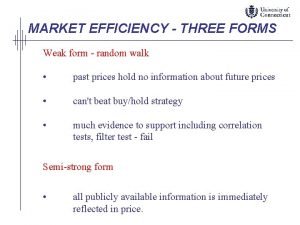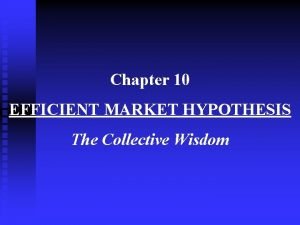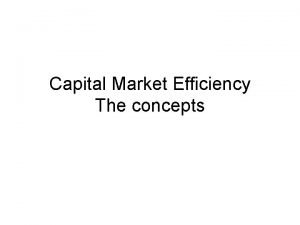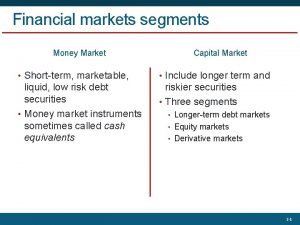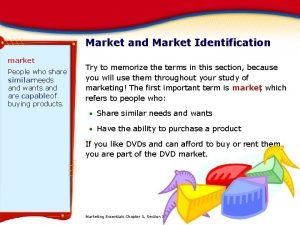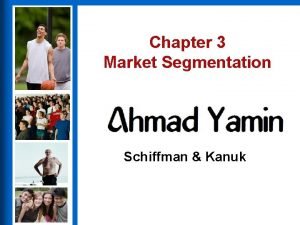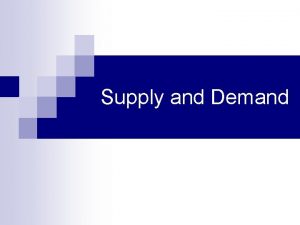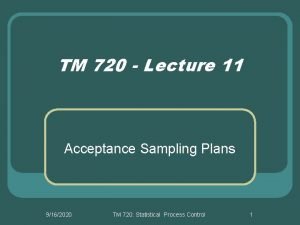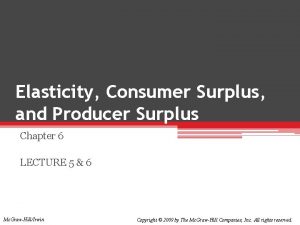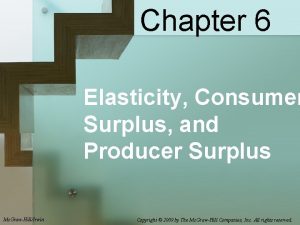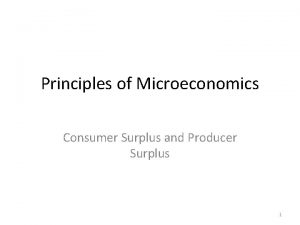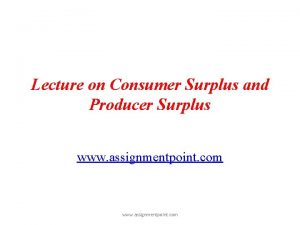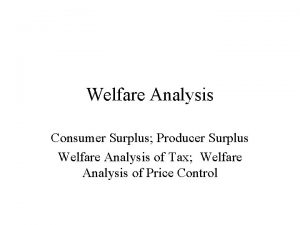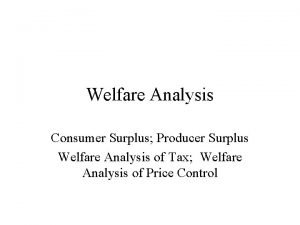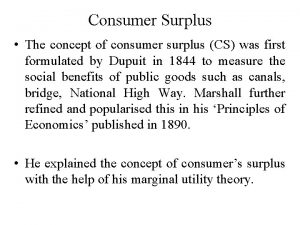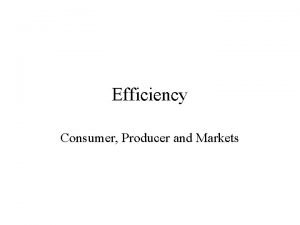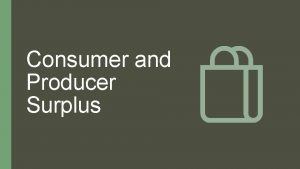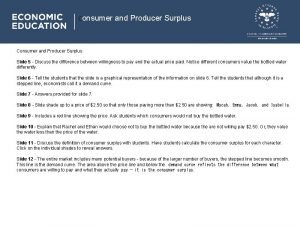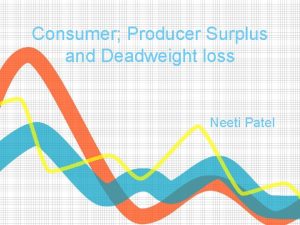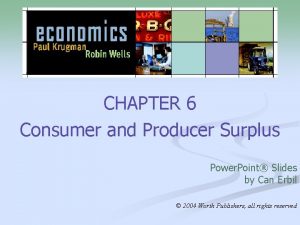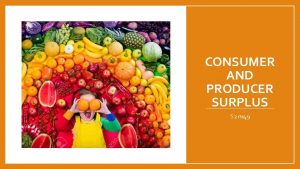Consumer Surplus Producer Surplus and Market Efficiency Consumer






























































- Slides: 62

Consumer Surplus, Producer Surplus, and Market Efficiency

Consumer Surplus and the Demand Curve n Example is the market for used textbooks, concentrating on the buyers. n The example is going to show that the demand curve is derived from people’s tastes or preferences and these tastes and preferences also determine how much they gain from the opportunity to buy used books.

Willingness to Pay n Maximum price at which he or she would buy a good n Individuals won’t buy the good if it costs more than this among but eager to do so if it cost less n If the price is just equal to an individual’s willingness to pay, he or she is indifferent between buying and not buying

The Demand Curve for Used Textbooks Price of book $59 Aleisha Potential buyers Brad 45 Claudia 35 Aleisha Brad $59 Claudia 35 Darren Edwina 25 45 10 Darren 25 Edwina 10 D 0 Willingness to pay 1 2 3 4 5 Quantity of books A consumer’s willingness to pay for a good is the maximum price at which he or she would buy that good.

Willingness to Pay n n Not a smooth curve because it is only dealing with a small number of consumers Each horizontal segment = how much one is willing to pay What is the quantity demanded at $59? What is the quantity demanded at $45?

Willingness to Pay & Consumer Surplus n Campus Bookstore makes used textbooks available at a price of $30. Who will buy books? n Do they gain from their purchase?

Consumer Surplus in the Used Textbook Market Price of book Aleisha’s consumer surplus: $59 -$39=$29 $59 Aleisha Brad’s consumer surplus: $45 -$30=$15 45 Brad Claudia’s consumer surplus: $35 -$30=$5 35 Claudia 30 Price = $30 25 Darren 10 Edwina The total consumer surplus is given by the entire shaded area - the sum of the individual consumer surpluses of Aleisha, Brad, and Claudia equal to $29 + $15 + $5 = $49. D 0 1 2 3 4 5 Quantity of books

Willingness to Pay & Consumer Surplus n n Individual Consumer Surplus – net gain that a buyer achieves from the purchase of a good n Whenever a buyer pays a price less than his or her willingness to pay, the buy achieves an individual consumer surplus Total Consumer Surplus – sum of the individual consumer surpluses achieved by all the buyers of a good n Aleisha, Brad and Claudia: $29 +$15 +$5 = $49

Consumer Surplus n Refers to both individual and total consumer surplus The total consumer surplus generated by purchases of a good at a given price is equal to the area below the demand curve but above that price n Total consumer surplus is equal to the area below the demand curve but above the price

Changing Prices Affects Consumer Surplus n Textbook Example again…. . n BUT……the bookstore has now decided to sell used textbooks for $20 instead of $30. How much would this fall in price increase consumer surplus?

Consumer Surplus and a Fall in the Price of Used Textbooks Price of book $59 Aleisha Increase in Aleisha’s consumer surplus Increase in Brad’s consumer surplus 45 Brad Claudia 35 Increase in Claude’s consumer surplus 30 Original price = $30 Darren 25 20 New price = $20 10 Darren’s consumer surplus Edwina D 0 1 2 3 4 5 Quantity of books

Changing Prices Affects Consumer Surplus n The graph showed that when the price of a good falls, the area under the demand curve but not above the price (which is equal to total consumer surplus) increases

Producer Surplus and the Supply Curve n We have buyers of goods that would be willing to pay more for their purchase than the price they actually pay n Some sellers of a good would have been willing to sell it for less than the price they actually receive

Producer Surplus and the Supply Curve n Seller’s cost – lowest price at which a potential seller is willing to sell n What is Andrew’s cost? What is Betty’s cost?

Producer Surplus and the Supply Curve n n Since the students don’t have to manufacture the books, does it cost the student who sells a book anything to make that book available for sale? YES! You won’t have it later in your personal collection – opportunity cost! When saying “cost” of a good as a seller, referring to selling that good even if you don’t spend any money to sell the good

Producer Surplus and the Supply Curve Individual Producer Surplus – the net gain, the difference between the price he actually gets and his cost, the minimum price at which he would have been willing to sell n Total Producer Surplus – the total net gain to all sellers in the market n Producer Surplus – refers to either the total or individual producer surplus n

Producer Surplus in the Used Textbook Market Total Producer Surplus is given by the entire shaded area, the sum of the individual producer surpluses of Andrew, Betty, and Carlos. $25 + $15 + $5 = $45 Price = $30 Carlos’s producer surplus Betty’s producer surplus Andrew’s producer surplus The total producer surplus from sales of a good at a given price is the area above the supply curve but below that price.

How Changing Price Affects Producer Surplus n. When the price of a good rises, producer surplus increases through two ways: n. The gains of those who would have supplied the good even at the original, lower price and n. The gains of those who are induced to supply the good by the higher price

A Rise in the Price Increases Producer Surplus Price of wheat (per bushel) Increase in producer surplus to original sellers Consumer surplus gained by new sellers S $7 5 0 1 million 1. 5 million Quantity of wheat (bushels)

Consumer Surplus, Producer Surplus, and the Gains from Trade n Total Surplus generated in a market is the total net gain to consumers and producers from trading in the market. It is the sum of the producer and the consumer surplus n This also shows there are gains from trade

Total Surplus Price of book S Equilibrium price $30 Consumer surplus E Producer surplus D 0 1, 000 Equilibrium quantity Quantity of books

The Efficiency of Markets n Markets are usually “efficient” n Are they? n It is claimed that once the market has produced its gains from trade, there is no way to make some people better off without making ofther people worse off, except…. . under well-defined conditions

The Efficiency of Markets n. A committee wants to improve on the market equilibrium by deciding who gets and who gives up a used textbook. The goal of the committee – bypass the market outcome and come up with another arrangement that would produce higher total surplus

The Efficiency of Markets n Three ways to increase the total surplus: 1. Reallocate consumption among consumers 2. Reallocate sales among sellers 3. Change the quantity traded

1. Reallocate consumption among consumers n Committee tries to increase total surplus by selling books to different consumers

2. Reallocate sales among sellers n Committee tried to increase total surplus by altering who sells their books, taking sales away from sellers who would have sold their books in the market equilibrium and instead compelling those who would not have sold their books in the market equilibrium to sell them

3. Change the quantity traded n Committee tries to increase total surplus by compelling students to trade either more books or fewer books than the market equilibrium quantity.

The Efficiency of Markets n Key Idea: once this market is in equilibrium, there is no way to increase the gains from trade n An efficient market performs four important functions

The Efficiency of Markets An efficient market performs four important functions 1. It allocates consumption of the good to the potential buyers who most value it, as indicated by the fact that they have the highest willingness to pay 2. It allocates sales to the potential sellers who most value the right to sell the good, as indicated by the fact that they have the lowest cost n

The Efficiency of Markets 3. 4. It ensures that every consumer who makes a purchase values the good more than every seller who makes a sale, so that all transactions are mutually beneficial It ensures that every potential buyer who doesn’t make a purchase values the good less than every potential seller who doesn’t make a sale, so that no mutually beneficial transaction are missed

The Efficiency of Markets Three caveats: 1. Market can be efficient, it isn’t necessarily fair 2. Markets sometimes fail 3. Even when market equilibrium maximizes total surplus, this does not mean that it results in the best outcome for every individual consumer and producer n

The Efficiency of Markets n Efficiency is about how to achieve goals, not what those goals should be

Consumer Surplus, Producer Surplus, and Market Efficiency Notes

Willingness to Pay n Individuals won’t buy the good if it costs more than this among but eager to do so if it cost less n If the price is just equal to an individual’s willingness to pay, he or she is indifferent between buying and not buying

The Demand Curve for Used Textbooks Price of book $59 Aleisha Potential buyers Brad 45 Claudia 35 Darren 25 Edwina 10 D 0 1 2 3 4 5 Quantity of books Willingness to pay Aleisha Brad $59 Claudia 35 Darren Edwina 25 45 10

Willingness to Pay n What is the quantity demanded at $59? n What is the quantity demanded at $45?

Willingness to Pay & Consumer Surplus n Campus Bookstore makes used textbooks available at a price of $30. Who will buy books? n Do they gain from their purchase?

Consumer Surplus in the Used Textbook Market Price of book Aleisha’s consumer surplus: $59 -$39=$29 $59 Aleisha Brad’s consumer surplus: $45 -$30=$15 45 Brad Claudia’s consumer surplus: $35 -$30=$5 35 Claudia 30 Price = $30 25 Darren 10 Edwina D 0 1 2 3 4 5 Quantity of books

Willingness to Pay & Consumer Surplus n Individual Consumer Surplus – net gain that a buyer achieves from the purchase of a good n Total Consumer Surplus – sum of the individual consumer surpluses achieved by all the buyers of a good

Consumer Surplus n Refers to both individual and total consumer surplus

Consumer Surplus and a Fall in the Price of Used Textbooks Price of book $59 Aleisha Increase in Aleisha’s consumer surplus Increase in Brad’s consumer surplus 45 Brad Claudia 35 Increase in Claude’s consumer surplus 30 Original price = $30 Darren 25 20 New price = $20 10 Darren’s consumer surplus Edwina D 0 1 2 3 4 5 Quantity of books

Changing Prices Affects Consumer Surplus n The graph showed that when the price of a good falls, the area under the demand curve but not above the price (which is equal to total consumer surplus) increases

Producer Surplus and the Supply Curve n We have buyers of goods that would be willing to pay more for their purchase than the price they actually pay

Producer Surplus and the Supply Curve n Seller’s cost – lowest price at which a potential seller is willing to sell n What is Andrew’s cost? What is Betty’s cost?

Producer Surplus and the Supply Curve n n Since the students don’t have to manufacture the books, does it cost the student who sells a book anything to make that book available for sale? YES!

Producer Surplus and the Supply Curve n Individual Producer Surplus – n Total Producer Surplus – n Producer Surplus –

Producer Surplus in the Used Textbook Market Price = $30 Carlos’s producer surplus Betty’s producer surplus Andrew’s producer surplus

How Changing Price Affects Producer Surplus n. When the price of a good rises, producer surplus increases through two ways:

A Rise in the Price Increases Producer Surplus Price of wheat (per bushel) Increase in producer surplus to original sellers Consumer surplus gained by new sellers S $7 5 0 1 million 1. 5 million Quantity of wheat (bushels)

Consumer Surplus, Producer Surplus, and the Gains from Trade n This also shows there are gains from trade

Total Surplus Price of book S Equilibrium price $30 Consumer surplus E Producer surplus D 0 1, 000 Equilibrium quantity Quantity of books

The Efficiency of Markets n Markets are usually “efficient” n Are they? n It is claimed that once the market has produced its gains from trade, there is no way to make some people better off without making ofther people worse off, except…. . under well-defined conditions

The Efficiency of Markets n. A committee wants to improve on the market equilibrium by deciding who gets and who gives up a used textbook. The goal of the committee – bypass the market outcome and come up with another arrangement that would produce higher total surplus

The Efficiency of Markets n Three ways to increase the total surplus: 1. Reallocate consumption among consumers 2. Reallocate sales among sellers 3. Change the quantity traded

1. Reallocate consumption among consumers n Committee tries to increase total surplus by selling books to different consumers

2. Reallocate sales among sellers n Committee tried to increase total surplus by altering who sells their books, taking sales away from sellers who would have sold their books in the market equilibrium and instead compelling those who would not have sold their books in the market equilibrium to sell them

3. Change the quantity traded n Committee tries to increase total surplus by compelling students to trade either more books or fewer books than the market equilibrium quantity.

The Efficiency of Markets n Key Idea: once this market is in equilibrium, there is no way to increase the gains from trade n An efficient market performs four important functions

The Efficiency of Markets An efficient market performs four important functions 1. It allocates consumption of the good to the potential buyers who most value it, as indicated by the fact that they have the highest willingness to pay 2. It allocates sales to the potential sellers who most value the right to sell the good, as indicated by the fact that they have the lowest cost n

The Efficiency of Markets 3. 4. It ensures that every consumer who makes a purchase values the good more than every seller who makes a sale, so that all transactions are mutually beneficial It ensures that every potential buyer who doesn’t make a purchase values the good less than every potential seller who doesn’t make a sale, so that no mutually beneficial transaction are missed

The Efficiency of Markets Three caveats: 1. Market can be efficient, it isn’t necessarily fair 2. Markets sometimes fail 3. Even when market equilibrium maximizes total surplus, this does not mean that it results in the best outcome for every individual consumer and producer n

The Efficiency of Markets n Efficiency is about how to achieve goals, not what those goals should be
 Producer
Producer Producer surplus
Producer surplus Producer surplus formula
Producer surplus formula How to calculate consumer and producer surplus
How to calculate consumer and producer surplus When are consumer and producer surplus maximized?
When are consumer and producer surplus maximized? Foodweb
Foodweb Total producer surplus formula
Total producer surplus formula Taxation and government intervention
Taxation and government intervention How to calculate consumer surplus
How to calculate consumer surplus Deadweight loss of tariff
Deadweight loss of tariff Allocative efficiency and productive efficiency
Allocative efficiency and productive efficiency Producer consumer decomposer activity
Producer consumer decomposer activity Consumer and producer
Consumer and producer Difference between consumer market and business market
Difference between consumer market and business market 1. individual demand and consumer surplus
1. individual demand and consumer surplus Allocative efficiency vs productive efficiency
Allocative efficiency vs productive efficiency Allocative efficiency vs productive efficiency
Allocative efficiency vs productive efficiency Market segmentation target and positioning
Market segmentation target and positioning Producer consumer decomposer meaning
Producer consumer decomposer meaning Producer
Producer Animals that eat both plants and animals
Animals that eat both plants and animals Producer examples
Producer examples Producer-consumer problem
Producer-consumer problem Producer-consumer problem
Producer-consumer problem Producer biology
Producer biology Producer-consumer problem
Producer-consumer problem Create a food chain of the following organisms
Create a food chain of the following organisms Government tariffs
Government tariffs Consumer surplus with subsidy
Consumer surplus with subsidy Consumer surplus in monopolistic competition
Consumer surplus in monopolistic competition Consumer surplus in a monopoly
Consumer surplus in a monopoly How does monopoly affect consumer surplus
How does monopoly affect consumer surplus Perfectly discriminating monopolist
Perfectly discriminating monopolist Perfectly price discriminating monopoly
Perfectly price discriminating monopoly Perfectly inelastic demand
Perfectly inelastic demand Tr
Tr Aplikasi integral dalam ekonomi dan bisnis
Aplikasi integral dalam ekonomi dan bisnis Market leader challenger follower nicher
Market leader challenger follower nicher Three forms of market efficiency
Three forms of market efficiency Random walk efficient market hypothesis
Random walk efficient market hypothesis What is market efficiency
What is market efficiency Characteristics of consumer behavior
Characteristics of consumer behavior Business buyer behavior refers to the
Business buyer behavior refers to the Desert herbivore
Desert herbivore Cengage
Cengage Consumer research process
Consumer research process Detrivores
Detrivores Primary target market and secondary target market
Primary target market and secondary target market Capital market
Capital market Identification marketing
Identification marketing Difference between primary market and secondary market
Difference between primary market and secondary market Short term funds
Short term funds Sociocultural segmentation example
Sociocultural segmentation example Analyzing consumer markets
Analyzing consumer markets Analysing consumer market
Analysing consumer market Demographic dimensions of consumer market
Demographic dimensions of consumer market Analyzing consumer markets and buyer behavior
Analyzing consumer markets and buyer behavior Analyzing consumer market
Analyzing consumer market Analyzing consumer market
Analyzing consumer market Surplus vs shortage
Surplus vs shortage Producer's risk
Producer's risk Producer definition geography
Producer definition geography Herbalife success builder
Herbalife success builder
